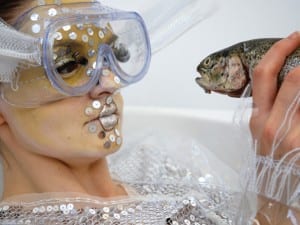Racial identity lies at the heart of the latest exhibition at Manchester’s HOME. Fittingly, the event is named after Douglas Sirk’s film Imitation of Life (1959). Sirk’s melodramatic style was influential as certain techniques – namely, kitschy visuals and over-bearing musical cues – were not escapist tools but were instead ways of revealing the falsity of Hollywood’s representative codes. This self-conscious approach, where the problems of visualising ‘blackness’ in an original way also forms the subject of those same visual works, is what ties these diverse creations together at Imitation of Life: Melodrama and Race in the 21st Century.
Larry Achiampong’s Glyph (2013-4), a selection of six digital prints, is the one which works most closely in the Sirkian tradition. Each picture is a digitally manipulated photograph derived from family photo albums, where the individual faces are all replaced with identical black circles with red lips. It is an unsettling allusion to the ‘golliwog’, but without appropriating that stereotype’s entire attributes. The lack of eyes, noses, ears or any other facial characteristics aside from the lips are a disconcerting reminder of stereotypes’ ability to dehumanise their subjects, and of Western media’s proclivity to misrepresent marginalised peoples as culturally homogenous.
A key aspect of melodrama is the use of bright colours, which is why Jordan Casteel sand Michael Armitage’s paintings are also showcased. Casteel’s Ato (2014), an oil on canvas depiction of a naked black man crouching almost in a foetal position in a chair, has a flattened, mannered appearance; his skin is etiolated, almost unvarnished in its pallor. His vulnerability is potent, even when the Harlem artist portrays him in bold, garish colours one would associate with pop art. Meanwhile, Armitage’s Kampala Suburb and Campus Divas (both 2014) may sound like he uses domestic settings too, but these two oil on Uganda bark cloth works are notably more abstract, as their rich colour palettes and hazy outlines suggest a fever dream.
Kevin Beasley’s Untitled (Fades/Violas) (2015), Tony Lewis’ quartet of pictures (2012-5) and Sophia Al-Maria’s Scarce New Flowers (2016) all de-familiarise everyday objects for effect. Untitled is a television mount drenched with African-American clothing, producing a sculptural collage; Tony Lewis takes notes written on paper and disassembles, smudges and spreads out the graphite letters across the stained landscape, reminding us of the limitations of language; and Al-Maria’s photographic series transforms the packaging for facial whitening creams into holographic facsimiles. These products, which are targeted at women across Asia and Africa, now look like vaporous emblems of empty promises.
Lauren Halsey’s We the ones (blackngold) (2016), a collection of bright and multi-coloured hair extensions which overspreads one of the gallery walls, is one of the few creations which is not a work of video art. The films are a mixture of art and theory. For the former, Jacolby Satterwhite’s Reifying Desire 6 (2014) and Matriarch’s Rhapsody (2012) uses both computer generated and analogue images to create a virtual reality bursting with martial arts and vogue dance moves. Loretta Fahrenholz’s Ditch Plains (2013), a ‘sci-fi street dance film’, similarly uses dance narratives to illustrate race relations.
In addition, Loulou Cherinet’s White Women (2012) features a dinner party wherein African men discuss blackness and masculinity, as Cherinet’s camera rotates around their table in a long 52-minute shot. Although provocative, the topical dialogue makes the film resemble a commentary like Martine Syms’ S1:E1 (2015), an installation that examines black identity in American sitcoms. Of all the theory-driven videos, the highlight is Jayson Musson’s hilarious ART THOUGHTZ (2010), an eight-minute YouTube clip of Musson outlining how to be a successful black artist. His advice: be angry, unpredictable, and challenging. “White people don’t really have any shared cultural traumas, you know,” Musson says. “Other than the shared disappointment of the series finale of Seinfeld.”
Charlie Bennett
Imitation of Life: Melodrama and Race in the 21st Century, until 3 July, HOME, 2 Tony Wilson Place, First Street, Manchester, M15 4FN. For more information, visit www.homemcr.org.
Credits:
1. Installation view from HOME, Photo Credit: Lee Baxter.





